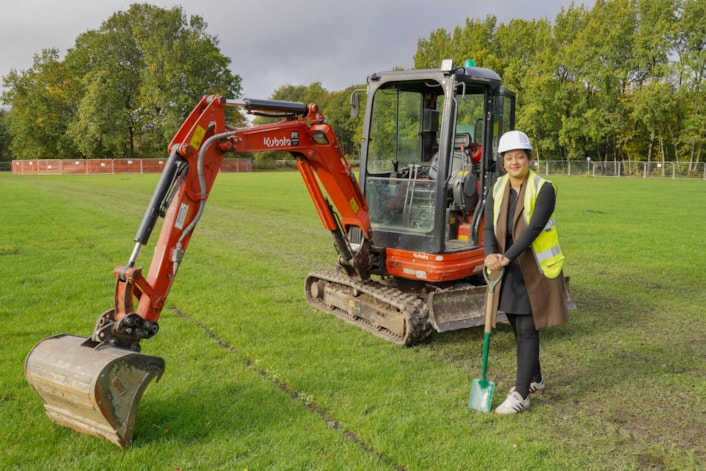Media library
Search by keyword
1882 items found, showing page 10 of 157

Cauldron
The cauldron is part of the collection at the Leeds Discovery Centre, a state-of-the-art facility which is home to more than a million objects.
The museum has recently been exploring fears and phobias over half term, with other spooky objects on display including Victorian clown dolls, a dentist-themed board game and an ageing ventriloquists dummy.

Cauldron
The cauldron is part of the collection at the Leeds Discovery Centre, a state-of-the-art facility which is home to more than a million objects.
The museum has recently been exploring fears and phobias over half term, with other spooky objects on display including Victorian clown dolls, a dentist-themed board game and an ageing ventriloquists dummy.

Saxon cross display
Believed to have once been a prestigious badge of office and a sign of religious identity, the silver, gilded pendant was discovered by a metal detectorist, with one of its four arms broken, and its central stone missing.
The newly created drawings, penned by archaeological illustrator John Prudhoe, show how the complete cross could have looked with its thin layer of gold leaf shining and a beautiful central garnet.

Saxon cross display
Curator of archaeology Kat Baxter with the ancient Saxon cross now on display at Leeds City Museum.
Believed to have once been a prestigious badge of office and a sign of religious identity, the silver, gilded pendant was discovered by a metal detectorist, with one of its four arms broken, and its central stone missing.
Newly created drawings, penned by archaeological illustrator John Prudhoe, show how the complete cross could have looked with its thin layer of gold leaf shining and a beautiful central garnet.

Saxon cross display
Believed to have once been a prestigious badge of office and a sign of religious identity, the silver, gilded pendant was discovered by a metal detectorist, with one of its four arms broken, and its central stone missing.
Newly created drawings, penned by archaeological illustrator John Prudhoe, show how the complete cross could have looked with its thin layer of gold leaf shining and a beautiful central garnet.

Saxon cross display
Curator of archaeology Kat Baxter with the ancient Saxon cross now on display at Leeds City Museum.
Believed to have once been a prestigious badge of office and a sign of religious identity, the silver, gilded pendant was discovered by a metal detectorist, with one of its four arms broken, and its central stone missing.
Newly created drawings, penned by archaeological illustrator John Prudhoe, show how the complete cross could have looked with its thin layer of gold leaf shining and a beautiful central garnet.

Saxon cross display
Curator of archaeology Kat Baxter with the ancient Saxon cross now on display at Leeds City Museum.
Believed to have once been a prestigious badge of office and a sign of religious identity, the silver, gilded pendant was discovered by a metal detectorist, with one of its four arms broken, and its central stone missing.
Newly created drawings, penned by archaeological illustrator John Prudhoe, show how the complete cross could have looked with its thin layer of gold leaf shining and a beautiful central garnet.

Saxon cross display
Curator of archaeology Kat Baxter with the ancient Saxon cross now on display at Leeds City Museum.
Believed to have once been a prestigious badge of office and a sign of religious identity, the silver, gilded pendant was discovered by a metal detectorist, with one of its four arms broken, and its central stone missing.
Newly created drawings, penned by archaeological illustrator John Prudhoe, show how the complete cross could have looked with its thin layer of gold leaf shining and a beautiful central garnet.

Saxon cross display
Believed to have once been a prestigious badge of office and a sign of religious identity, the silver, gilded pendant was discovered by a metal detectorist, with one of its four arms broken, and its central stone missing.
Newly created drawings, penned by archaeological illustrator John Prudhoe, show how the complete cross could have looked with its thin layer of gold leaf shining and a beautiful central garnet.

Saxon cross display
Newly created drawings, penned by archaeological illustrator John Prudhoe, show how the complete cross could have looked with its thin layer of gold leaf shining and a beautiful central garnet.
Credit John Prudhoe.

Cllr Arif Woodhall Sports Hub 2
Developers have started digging on Woodhall Sports Hub in Calverley, which is set to offer top class sports pitches and a completely new space for the community to meet.
Three new full-sized artificial 3G pitches and one new natural grass pitch will ensure that all local junior sports teams have equal access to quality facilities.
